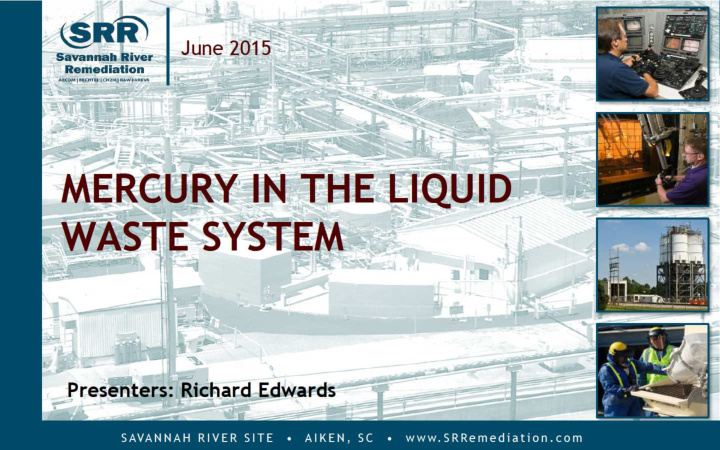



Purpose We do the right thing. Mercury has long been a consideration in the Liquid Waste System, both from a hazard and a processing perspective There have been no exposures, no releases, and all waste treatment complies with requirements However, there have been several recent examples of new information related to mercury in the Liquid Waste System – January 7, 2015 - Larger than expected amount of mercury collected from the 3H evaporator – February 3, 2015 – DOE requested S RR to conduct an evaluation of mercury through the entire Liquid Waste S ystem 4 th quarter 2014 TCLP (Toxic Characteristic Leaching Procedure) result for – February 3, 2015 – S altstone grout (sample taken October 2, 2014) above the LDR (Land Disposal Restriction) control limit of 0.025 mg/ L – April 1, 2015 – S pecial analysis of a sample from Tank 50 (feed to S altstone) showed higher than expected amounts of mercury in the form of mono-methyl mercury (~50 ppm vs. ~1 ppm) This presentation provides an overview of this new information and the near and long term actions related to mercury 2 S RR-ORG-2015-0000011 SAVANNAH RI VER SI T E • AI KEN, SC • w w w. SRRe m e d i a t i o n . c o m
Mercury in Liquid Waste We do the right thing. Mercury Removal (evaporators) Mercury Increasing Mercury Mercury Removal Trace Mercury No Mercury 3 S RR-ORG-2015-0000011 SAVANNAH RI VER SI T E • AI KEN, SC • w w w. SRRe m e d i a t i o n . c o m
Mercury in Liquid Waste We do the right thing. Mercury Originated from decades of canyon processing (used to aid reactor fuel dissolution) Is present throughout the liquid waste system (~60 metric tons) Is not a new issue • Removed at evaporators • S tripped and removed at DWPF • Removed at Effluent Treatment Plant • DOE approved an S RR plan to look for mercury accumulation in DWPF systems in FY2014 (identified that some mercury was being recycled to the tank farms) • Will need to remove about one 55-gal drum of mercury from the Liquid Waste S ystem every year for the remaining life of the program But the issue is changing • Higher mercury concentrations in H-area waste (H-area Tank Farm contains ~96% of the mercury) • S ome amount of mercury recycling from DWPF • Chemical forms of mercury may be changing (increases in soluble mercury and methylated mercury) Poses several challenges to waste processing • Equipment impacts • Potential flammability of certain chemical forms • S altstone grout performance • Performance Assessment 4 S RR-ORG-2015-0000011 SAVANNAH RI VER SI T E • AI KEN, SC • w w w. SRRe m e d i a t i o n . c o m
Near-Term Issues / Actions We do the right thing. Industrial hygiene and worker protection actions – Most radiological work practices also protect from mercury – Training conducted on methyl mercury hazards – As a precaution, prescribed use of nitrile gloves for all radiological work pending permeability testing of latex gloves and other materials (testing completed last week; removing this control) – Offer workers voluntary medical screening Increased frequency of mercury removal from evaporators Evaluating possible processing impacts of increased concentrations of methyl mercury prior to facility resumption (following outage activities) Performing additional sampling throughout the Liquid Waste System to determine concentrations and chemical forms of mercury (sampling scheme is defined, prioritized, and in-progress) 5 S RR-ORG-2015-0000011 SAVANNAH RI VER SI T E • AI KEN, SC • w w w. SRRe m e d i a t i o n . c o m
Long-Term Mercury Management We do the right thing. An integrated, system-wide evaluation of mercury behavior in the Liquid Waste System to identify – The inventory and chemical form of mercury throughout the Liquid Waste S ystem – The chemical processing behavior and accumulation of mercury in the liquid waste facilities – The impacts of mercury, including worker safety and equipment degradation – Mercury removal and disposal alternatives Established Mercury Expert Advisory Panel – Panel Members: • Dr. Lou Papouchado, Ret ired S RS / S RNL Chemist ry Expert ise • Dr. Eric Pierce, ORNL Mercury Expert • Mandi Richardson, AECOM Mercury Consult ant • Dr. Eric Prest bo, Tekran Corp. Chief S cient ist , Mercury Behavior & S peciat ion Expert – First review May 13 &14 • S RR’ s near-t erm approach and sampling schemes appear t o be sound Developing long-term action plan to address overall mercury management and removal. 6 S RR-ORG-2015-0000011 SAVANNAH RI VER SI T E • AI KEN, SC • w w w. SRRe m e d i a t i o n . c o m
Summary We do the right thing. Mercury is pervasive throughout the Liquid Waste System This is not a new issue, but we are seeing elevated levels There is no risk to the public or the environment Represents both a current and a long term challenge to liquid waste processing Worker safety continues to be a priority, worker protection continues to be effective, and conservative actions have been taken in response to new information Long term action plan under development 7 S RR-ORG-2015-0000011 SAVANNAH RI VER SI T E • AI KEN, SC • w w w. SRRe m e d i a t i o n . c o m
Recommend
More recommend